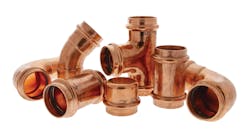Latest from Hydronics
Sponsored
I forgot to charge my electric car the other night. I forget a lot of things these days, but that was the first time for the car. I noticed that it wasn’t plugged into the wall charger when I walked into the garage to go to my first job site visit that morning.
The first thing my mind started calculating was the distance to and from my appointment in Dayton Ohio. I knew it was my only scheduled meeting for the day, so if I had enough charge left over from the previous day, I could work from the home office…
The estimated range on the dash indicated 97 miles. I know the distance between downtown Cincinnati and downtown Dayton is 54 miles because there are a few things I still remember. I used to obsess about maps and mileage when I was a kid on vacation. That, and Wyoming license plates. My dad would pay good money for the first sighting and I wanted that money and the satisfaction of being more observant than my five older sisters.
The second thing to check was the distance to the job site, which Apple Car Play told me was 47 miles. At least I could make it on time and then decide to charge up away from home or try to make it back. The little secret of electric vehicle range that I wasn’t aware of is the reduction in range in cold weather. My Ford MachE has a significant decrease in how far it goes as the outdoor temperature drops below, say, 40 degrees F.
To reduce electrical consumption, I turned off the heating, since in this car it is an electric heat pump. One of the first phone calls during the drive was from a heating contractor that does a lot of work for a remodeling contractor. He had just left a house where a wall needed to be removed and asked if he could replace original pipes with PEX pipe. I get a fair amount of inquiries about moving or removing walls with the popularity of the “open” floor plan concept.
Piping Puzzle
He wanted me to take a look and after he explained it, I wanted to see this for myself. I told him I was on my way north to Dayton for the morning. He asked if I could meet him after that. I told him a white lie about being busy, instead of the truth about not having enough charge in my car, and suggested the next morning. It was agreed that I would meet his hydronic guy at 9:00 to at least cap off the pipes so the carpenters could get something done.
The reason I wanted to see it for myself was the amount of pipes and their sizes. There were four pipes, even numbers of the same size are pretty common in hot water systems. Two of the pipes were ½”, which is uncommon in older homes. Typically the pipes in the walls are at least ¾”. Curiously, the other pipes were ¾” and 1-1/4”, which don’t match. To further muddy the waters, he told me the first floor was copper-fin baseboard while the second and third floors were cast iron radiators.
The address is in a nice neighborhood off a street with bigger houses built in the 1920s boom years. The people in these smaller homes have been trying to make their houses as large as they can to keep up with the neighbors since they moved in. Hence the number of calls about moving the pipes in the walls that are being removed with every new addition/remodel.
Following the Twisting Trail
It was just as he described when I got there, two ½” pipes coming out of the floor, going up inside the wall to be removed, across the ceiling in the joist pocket, then disappearing through the subfloor of the room above. The ¾” and 1-1/4” pipes were more exposed because the floor near them was removed. The 1-1/4” pipe was piped with two 45 degree elbows at the base instead of the typical one 90 degree elbow. I hadn’t seen that before.
At the top of the 1-1/4” line, it turned and ran 4 feet horizontally before it turned again and ran 4 feet to what appeared to be the original back wall of the house, where it turned up with a 1-1/4” by ¾” reducing elbow. Well, now we were back to the same pipe size.
The other ¾” line followed the same path from the floor to line up on the back wall before it turned up. It was pretty obvious that a cast iron radiator was above us between where the now two ¾” pipes disappeared through the subfloor.
Now it was time to take a look on the second floor, but the lady of the house was behind a closed door in the room(s) where the pipes ran. So we went the other direction to see what we could find in the basement. Unfortunately, the area below had been remodeled and the original piping was now behind drywall, except for two 12” x 12” access panels.
Once removed, there wasn’t much to see, except one asbestos covered pipe. The last place to look turned out to be the boiler room. Once again, somethings looked a little different. There were two asbestos covered supply lines leaving the boiler room, one going to the front and one going to the back, which seemed right. Then there were three small copper lines coming back in the ceiling, which could be explained by the baseboard on the first floor.
The Mystery Explained
But then there was one larger return pipe coming back that was about a foot off the floor. I then realized that the original system in the house was steam. That would explain the larger pipe going to the radiator and the smaller pipe returning from the radiator. With hot water it’s usually the same size, while steam it’s usually different. In this instance, the supply pipe is oversized because it ran over 6 feet horizontally. (I explained that in my May 2022 column.)
We went back upstairs to the exposed pipes so I could explain my silver sleuthing. Silver because I’m 67 years old this month. In the meantime, the carpenter had removed the floor by the ½” pipes to reveal that they were already cut off below the floor. So now we only had the 1-1/4” and ¾” pipes to cap off. When they go back to hook the radiator back up, they can transition to ¾” PEX for both the supply and return.
I made it back home from Dayton with 24 miles of range left. I even turned the heat on for the trip back.
Patrick Linhardt is a thirty-seven-year veteran of the wholesale side of the hydronic industry who has been designing and troubleshooting steam and hot water heating systems, pumps and controls on an almost daily basis. An educator and author, he is currently Hydronic Manager at the Corken Steel Products Co.
Patrick Linhardt
Patrick Linhardt is a forty-one-year veteran of the wholesale side of the hydronic industry who has been designing and troubleshooting steam and hot water heating systems, pumps and controls on an almost daily basis. An educator and author, he is currently Hydronic Manager at the Corken Steel Products Co.


